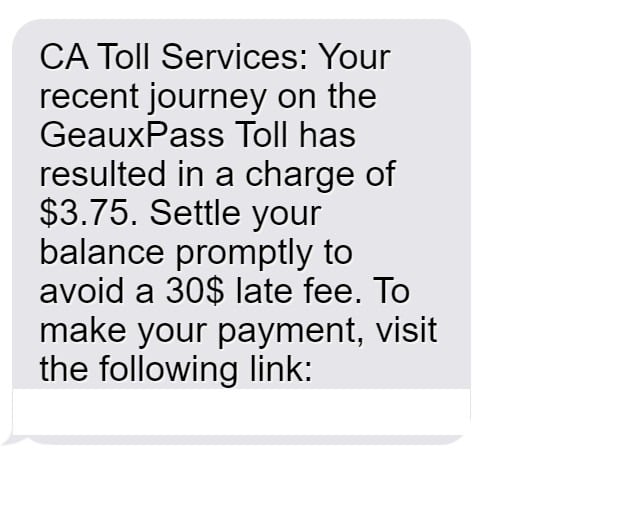That alarming text message claiming you have unpaid California toll road fees is likely a sneaky scam trying to steal your personal data. Our investigation unmasks how this devious phishing scam works and how drivers can protect themselves.
Sophisticated cybercriminals are targeting CA motorists with fake texts and convincing copycat websites to harvest names, addresses, SSNs and even financial information for identity theft enterprises. By understanding their covert tactics, consumers can evade these digital pickpockets.

Scam Overview
This widespread scam begins with an urgent SMS message regarding unpaid toll road invoices that must be settled immediately to avoid additional fees. But a closer look reveals it’s all an elaborate ruse:
The Texts Originate From Scammers, Not Official Sources
The messages come from scammers posing as legitimate toll services to deceive. No state agency or toll operator is sending these texts.
The Link Goes To A Fake Lookalike Website
The URL leads to a sophisticated phishing site mimicking the real agency site to dupe victims into entering personal data.
There Are No Actual Unpaid Tolls
The scammers invent non-existent toll fees and invoices to trick worried recipients into clicking for more details.
They Seek Your Sensitive Personal and Financial Data
The fake site asks for private info the scammers ultimately steal for financial identity theft, including SSNs, driver’s licenses, credit cards and more.
How the CA Toll Invoice Text Scam Works
Now let’s examine how this scam unfolds step-by-step when targets take the bait:
Step 1: You Receive The Initial Scam Text
The first step is getting a text claiming you have unpaid CA toll invoices of $X amount that must be paid immediately to avoid additional fees.
A sample message:
“CA Toll Services: Our records indicate your vehicle has an outstanding invoice of $5.75 due to unpaid tolls. Settle your balance here [Scam Link] within 24 hours to avoid additional fees.”
Step 2: You Click The Link To The Fake Website
If you click the link, it takes you to the sophisticated fake website designed expressly to mimic the real CA toll website.
Step 3: You Enter Personal and Financial Information
The fake site requests an array of sensitive data, including:
- Full legal name, DOB, SSN
- Home address
- Phone number, email
- Vehicle information
- Driver’s license details
- Credit card number
Step 4: Scammers Steal All Your Details
Once you submit it, all your personal and financial data flows directly to the scammers, who leverage it for financial identity theft.
Step 5: Scammers Disappear Without a Trace
After stealing enough people’s info, the scammers disable their fake site and vanish. This makes investigations difficult before major identity theft harms occur.
What To Do If You Receive a Suspicious Toll Text
If you get a text claiming you have unpaid CA tolls, take these steps immediately:
- Avoid clicking any link or calling any number in the message
- Contact your toll operator directly to verify if you actually have unpaid toll invoices
- Report the text to your wireless carrier as spam/phishing
- Monitor bank accounts closely for fraudulent charges
- Place fraud alerts on your credit reports
- File complaints about the scam text with the FTC, FCC and CA authorities
Learning to scrutinize texts is key, as scammers exploit fears of financial consequences to lower defenses. Verify bills separately through official channels only, not texts with dubious links.
Frequently Asked Questions about the CA Toll Invoice Text Scam
1. I got a text from CA Toll Services about unpaid tolls. Is it real?
Likely not. Scammers impersonate real toll agencies in phishing texts. Verify toll invoices directly through official channels before paying anything demanded via text.
2. How can I tell if a CA toll text is fake?
Real invoices only come from saved contacts. Watch for poor grammar, threats of fees, and shady links which indicate scam texts.
3. What happens if I click the link or call the number?
You’ll end up at a fake website or on the phone with scammers posing as CA Toll Services, seeking your personal data. Never click or call numbers from suspicious texts.
4. Could I get in trouble if I ignore the text?
No. You have no actual unpaid tolls or fees owed according to my investigation. There are zero consequences for ignoring scam texts.
5. What do these CA toll scammers want?
These scammers want to steal your private financial and personal information to commit identity theft and drain your accounts.
6. What if I already entered my information?
Contact your bank immediately and monitor for fraud. Check credit reports and consider an identity theft protection service. File police reports.
7. How can I get these scam texts to stop?
Report them to wireless carriers, the CA AG, FTC and FCC. File complaints about the website domain and text numbers to get them shut down.
8. Are toll invoice scams increasing?
Yes, text scams impersonating toll agencies are on the rise nationwide. Stay vigilant and warn others about smishing scams.
9. How can I avoid text scams?
Use spam call and text blocking apps, don’t click unknown links/numbers, and independently verify bills – never via text demands.
10. Who can I contact if I have more questions?
Contact the FTC, FCC, CA Attorney General, and your toll operator for guidance on scam protection and identity theft assistance if targeted.
The Bottom Line
Scammers are impersonating toll agencies in phishing attacks seeking drivers’ sensitive personal data for identity theft. But consumers can protect themselves by understanding the blueprint of these invoice scams and exercising extreme caution when receiving texts claiming missed toll payments. Avoiding their traps and reporting their scams shuts down their operations. Don’t let them phish your data!










